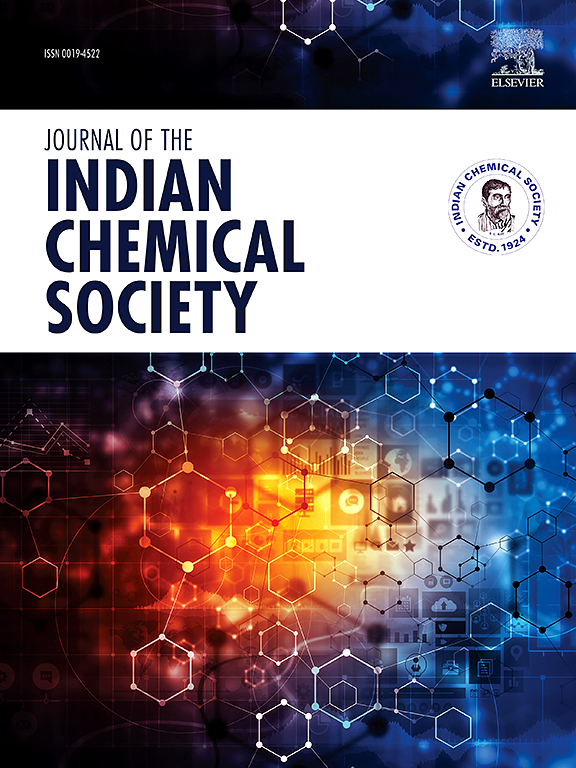巴贝特芦荟米勒基金属复合材料在光催化降解活性染料和阳离子染料及抗菌方面的应用
IF 3.2
4区 化学
Q2 CHEMISTRY, MULTIDISCIPLINARY
引用次数: 0
摘要
由于两种金属的协同作用,双金属纳米颗粒与单金属纳米颗粒相比,其性能的提高引起了人们的广泛关注。本文首次利用芦荟提取物(作为盖层和还原剂)通过水热法制备了双金属铜铬纳米颗粒(Cu - Cr@BMNPs)。所制备的纳米颗粒包覆有机基团,具有抗菌活性,并应用于废水处理。计算得到的z-平均尺寸为200 ~ 250 nm,证明在纳米范围内形成了颗粒,而在pH 8.2时达到了零电荷点。带隙能量测试结果表明,Cu - Cr@BMNPs具有比单金属纳米粒子更小的带隙能量。扫描电子显微镜的数字图像清晰地显示了合成颗粒的不规则和多孔表面,同时通过x射线衍射谱证实了样品的纯度。合成的Cu - Cr@BMNPs用于降解活性黑(RB)和孔雀石绿(MG)染料。在pH为3、催化剂剂量为15 mg、染料浓度为25 ppm、暴露时间为60 min时,RB的最大降解率为85%。mg在pH为8、催化剂剂量为20 mg、染料浓度为25 ppm、暴露时间为60 min时,最大降解率为97%。在不同的动力学模型中,Behnajady-Modirshahla-Ghanbery模型最符合实验数据。制备的BMNPs对大肠杆菌和金黄色葡萄球菌的生长有良好的抑制作用,抑制带为8 mm。因此,Cu - Cr@BMNPs被认为是光催化降解染料和抗菌剂的一个很有前途的工具。本文章由计算机程序翻译,如有差异,请以英文原文为准。

Aloe barbadensis miller-based metallic composites for photocatalytic degradation of reactive and cationic dyes and antimicrobial applications
Due to the synergistic effect of the two metals, bimetallic nanoparticles have attracted a lot of attention by boosting their properties as compared to monometallic nanoparticles. Herein, for the first time, bimetallic copper-chromium (Cu–Cr@BMNPs) nanoparticles using Aloe Vera extract (as a capping and reducing agent) were prepared via a hydrothermal approach. The prepared nanoparticles capped with organic moieties and antibacterial activity were employed in wastewater treatment. The calculated z-average size was 200–250 nm, which proved the formation of particles in the nano-range, while a point of zero charge was attained at pH 8.2. The results of band gap energy revealed that Cu–Cr@BMNPs have less energy band gap than monometallic nanoparticles. Digital images of Scanning electron microscopy clearly illustrate irregular and porous surfaces of synthesized particles, while purity of the sample was confirmed through X-ray diffraction spectrum. Synthesized Cu–Cr@BMNPs were used to degrade Reactive Black (RB) and Malachite Green (MG) dyes. The maximum degradation of RB was 85 % at pH 3, catalyst dose of 15 mg, dye concentration of 25 ppm, and exposure time of 60 min. For MG, the maximum degradation of 97 % was observed at pH 8, catalyst dose 20 mg, dye concentration 25 ppm, and time 60 min. Among different kinetic models, the Behnajady-Modirshahla-Ghanbery model was best fitted to the experimental data. Prepared BMNPs showed promising inhibition in the growth of two tested strains E. coli and Staph aureus with a zone of 8 mm. Therefore, Cu–Cr@BMNPs were found to be a promising tool for photocatalytic degradation of dyes as well as antibacterial agents.
求助全文
通过发布文献求助,成功后即可免费获取论文全文。
去求助
来源期刊
CiteScore
3.50
自引率
7.70%
发文量
492
审稿时长
3-8 weeks
期刊介绍:
The Journal of the Indian Chemical Society publishes original, fundamental, theorical, experimental research work of highest quality in all areas of chemistry, biochemistry, medicinal chemistry, electrochemistry, agrochemistry, chemical engineering and technology, food chemistry, environmental chemistry, etc.

 求助内容:
求助内容: 应助结果提醒方式:
应助结果提醒方式:


